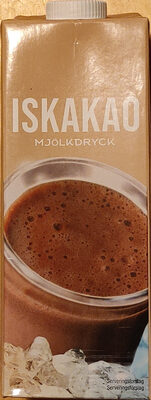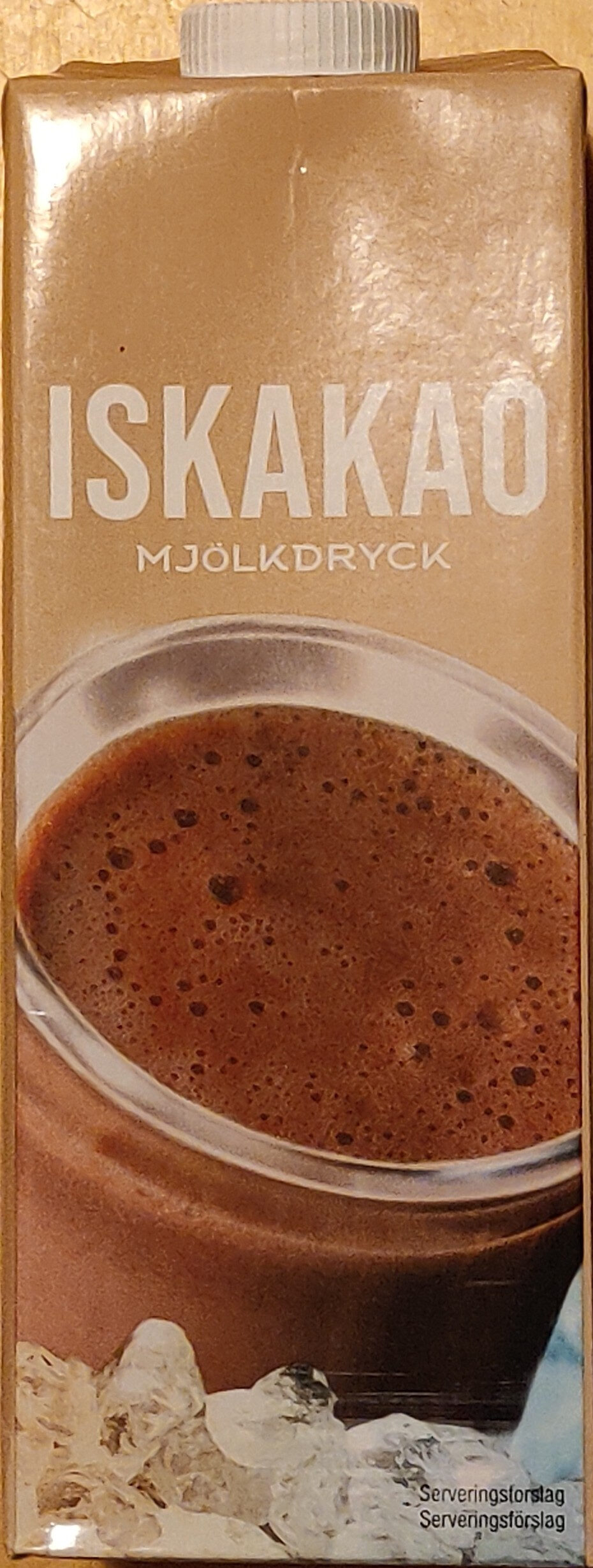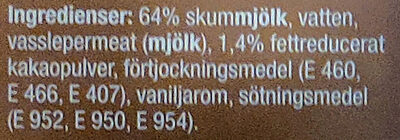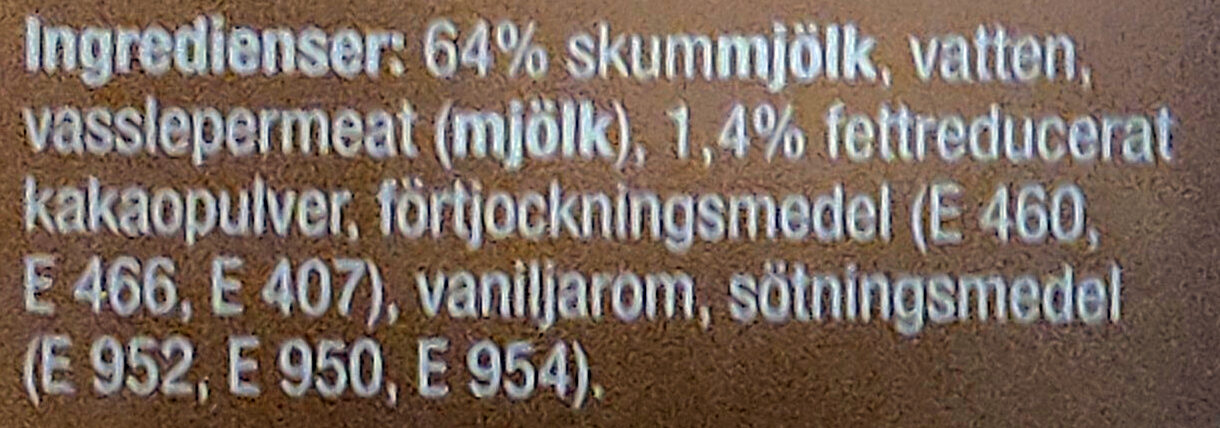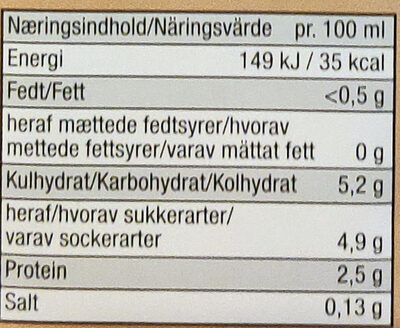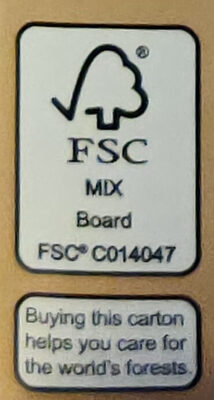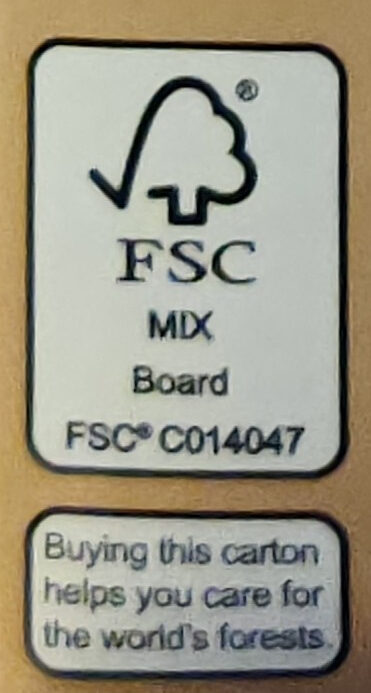Help us make food transparency the norm!
As a non-profit organization, we depend on your donations to continue informing consumers around the world about what they eat.
The food revolution starts with you!
Iskakao - Geia Food - 1 L
Iskakao - Geia Food - 1 L
Barcode: 7350024489156 (EAN / EAN-13)
Common name: Mjölkdryck med kakao. Innehåller sötningsmedel. UHT-behandlad.
Quantity: 1 L
Packaging: Paper, Tetra Pak, FSC paper
Brands: Geia Food, Geia Food A/S
Categories: Beverages, Dairies, Dairy drinks, Artificially sweetened beverages, Flavoured milks, Chocolate milks
Labels, certifications, awards:
FSC, FSC Mix, FSC C014047
Origin of ingredients: Germany
Manufacturing or processing places: Tyskland, Germany, Deutschland
Traceability code: DE HE-001 EG, FSC-C014047
Stores: Hemköp
Countries where sold: Sweden
Matching with your preferences
Health
Ingredients
-
13 ingredients
: 64% skummjölk, vatten, vasslepermeat (mjölk), 1,4% fettreducerat kakaopulver, förtjockningsmedel (E 460, E 466, E 407), vaniljarom, sötningsmedel (E 952, E 950, E 954).Allergens: Milk
Food processing
-
Ultra processed foods
Elements that indicate the product is in the 4 - Ultra processed food and drink products group:
- Additive: E407 - Carrageenan
- Additive: E460 - Cellulose
- Additive: E466 - Sodium carboxy methyl cellulose
- Additive: E950 - Acesulfame k
- Additive: E952 - Cyclamic acid and its Na and Ca salts
- Additive: E954 - Saccharin and its salts
- Ingredient: Flavouring
- Ingredient: Sweetener
- Ingredient: Thickener
- Ingredient: Whey
Food products are classified into 4 groups according to their degree of processing:
- Unprocessed or minimally processed foods
- Processed culinary ingredients
- Processed foods
- Ultra processed foods
The determination of the group is based on the category of the product and on the ingredients it contains.
Additives
-
E407 - Carrageenan
Carrageenan (E407), derived from red seaweed, is widely employed in the food industry as a gelling, thickening, and stabilizing agent, notably in dairy and meat products.
It can exist in various forms, each imparting distinct textural properties to food.
However, its degraded form, often referred to as poligeenan, has raised health concerns due to its potential inflammatory effects and its classification as a possible human carcinogen (Group 2B) by the International Agency for Research on Cancer (IARC).
Nevertheless, food-grade carrageenan has been deemed safe by various regulatory bodies when consumed in amounts typically found in food.
-
E460 - Cellulose
Cellulose: Cellulose is an organic compound with the formula -C6H10O5-n, a polysaccharide consisting of a linear chain of several hundred to many thousands of β-1→4- linked D-glucose units. Cellulose is an important structural component of the primary cell wall of green plants, many forms of algae and the oomycetes. Some species of bacteria secrete it to form biofilms. Cellulose is the most abundant organic polymer on Earth. The cellulose content of cotton fiber is 90%, that of wood is 40–50%, and that of dried hemp is approximately 57%.Cellulose is mainly used to produce paperboard and paper. Smaller quantities are converted into a wide variety of derivative products such as cellophane and rayon. Conversion of cellulose from energy crops into biofuels such as cellulosic ethanol is under development as a renewable fuel source. Cellulose for industrial use is mainly obtained from wood pulp and cotton.Some animals, particularly ruminants and termites, can digest cellulose with the help of symbiotic micro-organisms that live in their guts, such as Trichonympha. In human nutrition, cellulose is a non-digestible constituent of insoluble dietary fiber, acting as a hydrophilic bulking agent for feces and potentially aiding in defecation.Source: Wikipedia
-
E466 - Sodium carboxy methyl cellulose
Carboxymethyl cellulose: Carboxymethyl cellulose -CMC- or cellulose gum or tylose powder is a cellulose derivative with carboxymethyl groups --CH2-COOH- bound to some of the hydroxyl groups of the glucopyranose monomers that make up the cellulose backbone. It is often used as its sodium salt, sodium carboxymethyl cellulose.Source: Wikipedia
-
E950 - Acesulfame k
Acesulfame potassium: Acesulfame potassium - AY-see-SUL-faym-, also known as acesulfame K -K is the symbol for potassium- or Ace K, is a calorie-free sugar substitute -artificial sweetener- often marketed under the trade names Sunett and Sweet One. In the European Union, it is known under the E number -additive code- E950. It was discovered accidentally in 1967 by German chemist Karl Clauss at Hoechst AG -now Nutrinova-. In chemical structure, acesulfame potassium is the potassium salt of 6-methyl-1‚2,3-oxathiazine-4-3H--one 2‚2-dioxide. It is a white crystalline powder with molecular formula C4H4KNO4S and a molecular weight of 201.24 g/mol.Source: Wikipedia
-
E952 - Cyclamic acid and its Na and Ca salts
Cyclamic acid: Cyclamic acid is a compound with formula C6H13NO3S. It is included in E number "E952". Cyclamic acid is mainly used as catalyst in the production of paints and plastics, and furthermore as a reagent for laboratory usage.The sodium and calcium salts of cyclamic acid are used as artificial sweeteners under the name cyclamate.Source: Wikipedia
-
E954 - Saccharin and its salts
Saccharin: Sodium saccharin -benzoic sulfimide- is an artificial sweetener with effectively no food energy. It is about 300–400 times as sweet as sucrose but has a bitter or metallic aftertaste, especially at high concentrations. Saccharin is used to sweeten products such as drinks, candies, cookies, and medicines.Source: Wikipedia
Ingredients analysis
-
Palm oil free
No ingredients containing palm oil detected
-
Non-vegan
Non-vegan ingredients: Skimmed milk, Whey permeate
-
Maybe vegetarian
Ingredients that may not be vegetarian: Whey permeate, Vanilla flavouring
-
Details of the analysis of the ingredients
: _skummjölk_ 64%, vatten, vasslepermeat, fettreducerat kakaopulver 1.4%, förtjockningsmedel (e460, e466, e407), vaniljarom, sötningsmedel (e952, e950, e954)- _skummjölk_ -> en:skimmed-milk - vegan: no - vegetarian: yes - ciqual_proxy_food_code: 19051 - percent_min: 64 - percent: 64 - percent_max: 64
- vatten -> en:water - vegan: yes - vegetarian: yes - ciqual_food_code: 18066 - percent_min: 6 - percent_max: 33.2
- vasslepermeat -> en:whey-permeate - vegan: no - vegetarian: maybe - percent_min: 1.4 - percent_max: 28.6
- fettreducerat kakaopulver -> en:fat-reduced-cocoa-powder - vegan: yes - vegetarian: yes - ciqual_food_code: 18100 - percent_min: 1.4 - percent: 1.4 - percent_max: 1.4
- förtjockningsmedel -> en:thickener - percent_min: 0 - percent_max: 1.4
- e460 -> en:e460 - vegan: yes - vegetarian: yes - percent_min: 0 - percent_max: 1.4
- e466 -> en:e466 - vegan: yes - vegetarian: yes - percent_min: 0 - percent_max: 0.7
- e407 -> en:e407 - vegan: yes - vegetarian: yes - percent_min: 0 - percent_max: 0.466666666666667
- vaniljarom -> en:vanilla-flavouring - vegan: maybe - vegetarian: maybe - percent_min: 0 - percent_max: 1.4
- sötningsmedel -> en:sweetener - percent_min: 0 - percent_max: 1.4
- e952 -> en:e952 - vegan: yes - vegetarian: yes - percent_min: 0 - percent_max: 1.4
- e950 -> en:e950 - vegan: yes - vegetarian: yes - percent_min: 0 - percent_max: 0.7
- e954 -> en:e954 - vegan: yes - vegetarian: yes - ciqual_food_code: 31064 - percent_min: 0 - percent_max: 0.466666666666667
Nutrition
-
Poor nutritional quality
⚠ ️Warning: the amount of fiber is not specified, their possible positive contribution to the grade could not be taken into account.⚠ ️Warning: the amount of fruits, vegetables and nuts is not specified on the label, it was estimated from the list of ingredients: 0This product is considered a beverage for the calculation of the Nutri-Score.
Positive points: 1
- Proteins: 1 / 5 (value: 2.5, rounded value: 2.5)
- Fiber: 0 / 5 (value: 0, rounded value: 0)
- Fruits, vegetables, nuts, and colza/walnut/olive oils: 0 / 10 (value: 0, rounded value: 0)
Negative points: 9
- Energy: 5 / 10 (value: 149, rounded value: 149)
- Sugars: 4 / 10 (value: 4.9, rounded value: 4.9)
- Saturated fat: 0 / 10 (value: 0, rounded value: 0)
- Sodium: 0 / 10 (value: 52, rounded value: 52)
The points for proteins are counted because the negative points are less than 11.
Nutritional score: (9 - 1)
Nutri-Score:
-
Nutrient levels
-
Fat in low quantity (0.5%)
What you need to know- A high consumption of fat, especially saturated fats, can raise cholesterol, which increases the risk of heart diseases.
Recommendation: Limit the consumption of fat and saturated fat- Choose products with lower fat and saturated fat content.
-
Saturated fat in low quantity (0%)
What you need to know- A high consumption of fat, especially saturated fats, can raise cholesterol, which increases the risk of heart diseases.
Recommendation: Limit the consumption of fat and saturated fat- Choose products with lower fat and saturated fat content.
-
Sugars in moderate quantity (4.9%)
What you need to know- A high consumption of sugar can cause weight gain and tooth decay. It also augments the risk of type 2 diabetes and cardio-vascular diseases.
Recommendation: Limit the consumption of sugar and sugary drinks- Sugary drinks (such as sodas, fruit beverages, and fruit juices and nectars) should be limited as much as possible (no more than 1 glass a day).
- Choose products with lower sugar content and reduce the consumption of products with added sugars.
-
Salt in low quantity (0.13%)
What you need to know- A high consumption of salt (or sodium) can cause raised blood pressure, which can increase the risk of heart disease and stroke.
- Many people who have high blood pressure do not know it, as there are often no symptoms.
- Most people consume too much salt (on average 9 to 12 grams per day), around twice the recommended maximum level of intake.
Recommendation: Limit the consumption of salt and salted food- Reduce the quantity of salt used when cooking, and don't salt again at the table.
- Limit the consumption of salty snacks and choose products with lower salt content.
-
-
Nutrition facts
Nutrition facts As sold
for 100 g / 100 mlCompared to: Chocolate milks Energy 149 kj
(35 kcal)-52% Fat < 0.5 g -73% Saturated fat 0 g -100% Carbohydrates 5.2 g -51% Sugars 4.9 g -51% Fiber ? Proteins 2.5 g -28% Salt 0.13 g -16% Fruits‚ vegetables‚ nuts and rapeseed‚ walnut and olive oils (estimate from ingredients list analysis) 0 %
Environment
-
Eco-Score C - Moderate environmental impact
⚠ ️Select a country in order to include the full impact of transportation.The Eco-Score is an experimental score that summarizes the environmental impacts of food products.→ The Eco-Score was initially developped for France and it is being extended to other European countries. The Eco-Score formula is subject to change as it is regularly improved to make it more precise and better suited to each country.Life cycle analysis
-
Average impact of products of the same category: C (Score: 49/100)
Category: Chocolate flavoured milk, with sugar, partially skimmed, fortified with vitamins and chemicals elements
- PEF environmental score: 0.16 (the lower the score, the lower the impact)
- including impact on climate change: 1.38 kg CO2 eq/kg of product
Stage Impact Agriculture
56.9 %Processing
0.9 %Packaging
24.9 %Transportation
10.1 %Distribution
5.7 %Consumption
1.6 %
Bonuses and maluses
-
Origins of ingredients with a medium impact
Bonus: +4
Environmental policy: +4
Transportation: 0
Origin of the product and/or its ingredients % of ingredients Impact Germany 100 %Medium
-
Packaging with a low impact
Malus: -4
Shape Material Recycling Impact Brick Tetra Pak Medium
Eco-Score for this product
-
Impact for this product: C (Score: 49/100)
Product: Iskakao - Geia Food - 1 L
Life cycle analysis score: 49
Sum of bonuses and maluses: 0
Final score: 49/100
-
Carbon footprint
-
Equal to driving 0.7 km in a petrol car
138 g CO² per 100g of product
The carbon emission figure comes from ADEME's Agribalyse database, for the category: Chocolate flavoured milk, with sugar, partially skimmed, fortified with vitamins and chemicals elements (Source: ADEME Agribalyse Database)
Stage Impact Agriculture
68.6 %Processing
0.8 %Packaging
12.9 %Transportation
14.7 %Distribution
2.6 %Consumption
0.5 %
Packaging
-
Packaging with a low impact
-
Packaging parts
Brick (Tetra Pak)
-
Packaging materials
Material % Packaging weight Packaging weight per 100 g of product
-
Transportation
-
Origins of ingredients
Origins of ingredients with a medium impact
Origin of the product and/or its ingredients % of ingredients Impact Germany 100 %Medium
Report a problem
-
Incomplete or incorrect information?
Category, labels, ingredients, allergens, nutritional information, photos etc.
If the information does not match the information on the packaging, please complete or correct it. Open Food Facts is a collaborative database, and every contribution is useful for all.
Data sources
Product added on by akitainu
Last edit of product page on by akitainu.
Product page also edited by ecoscore-impact-estimator, openfoodfacts-contributors, roboto-app.
